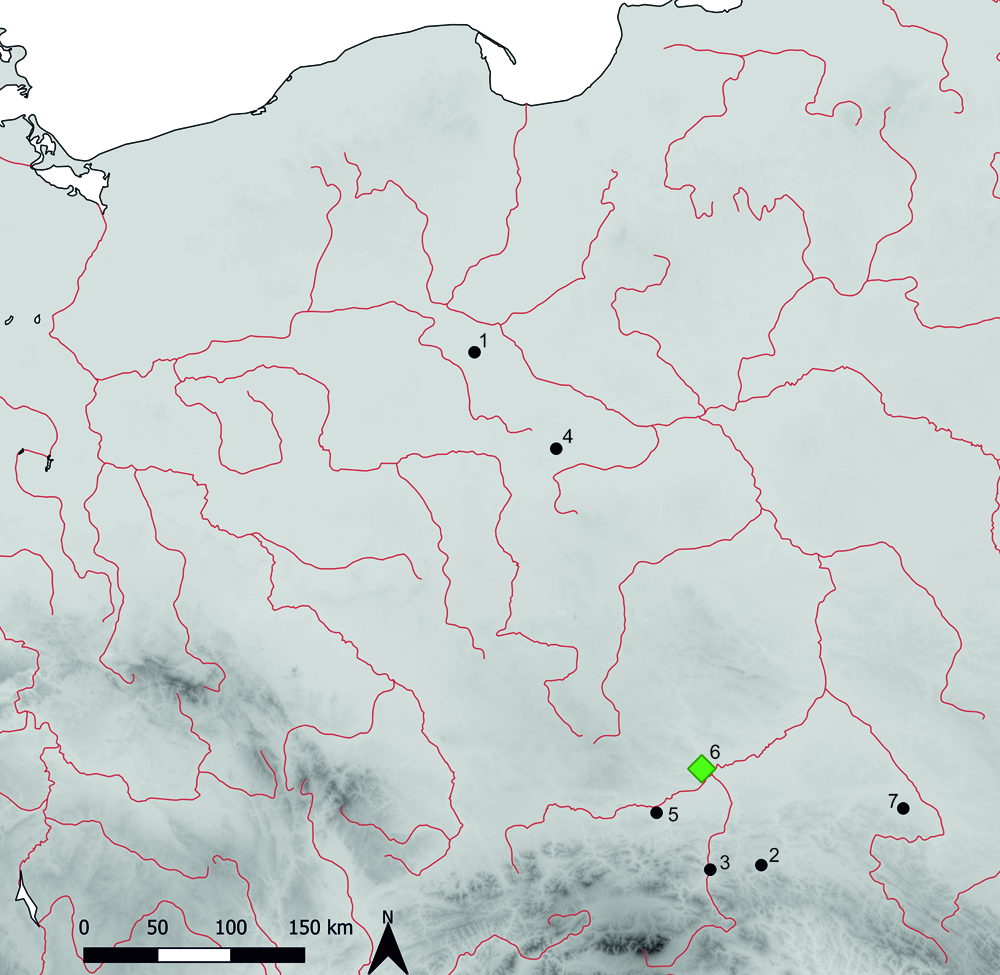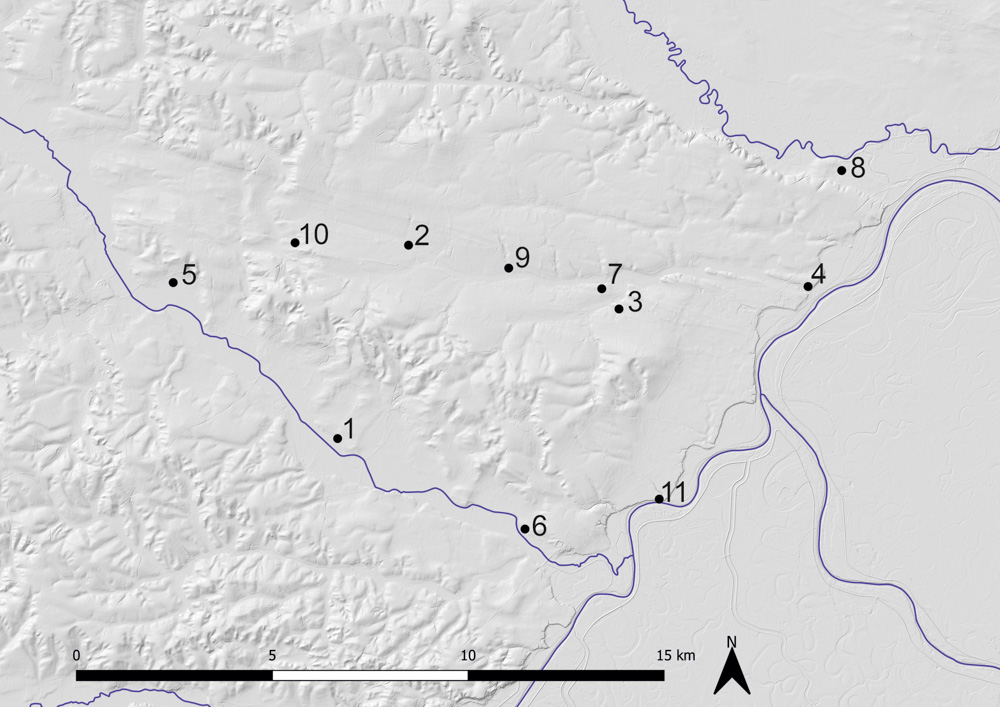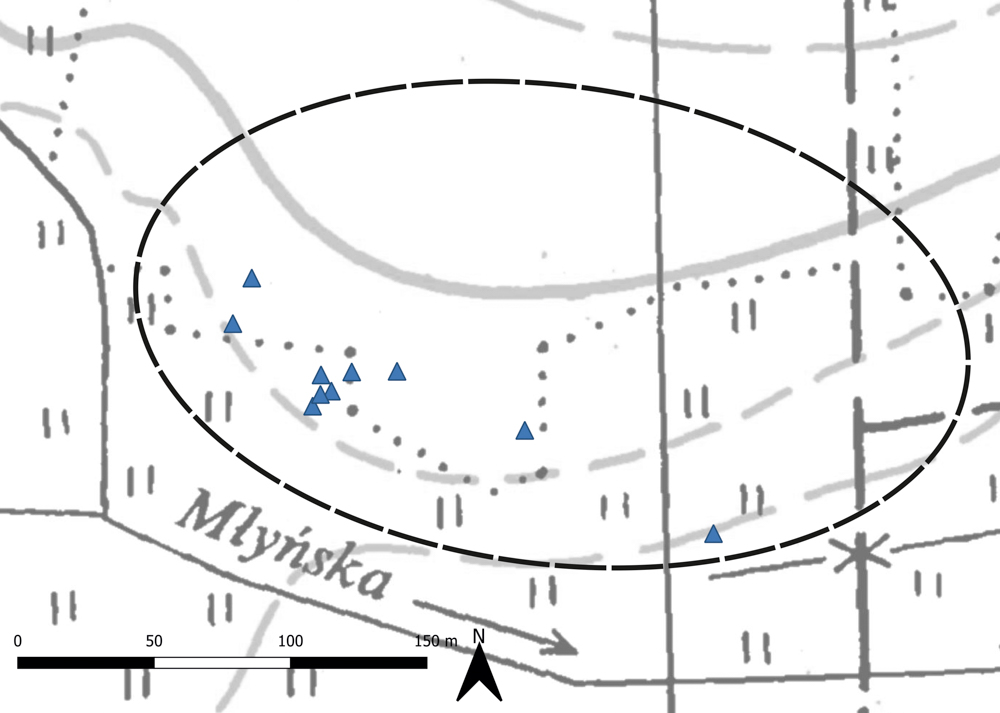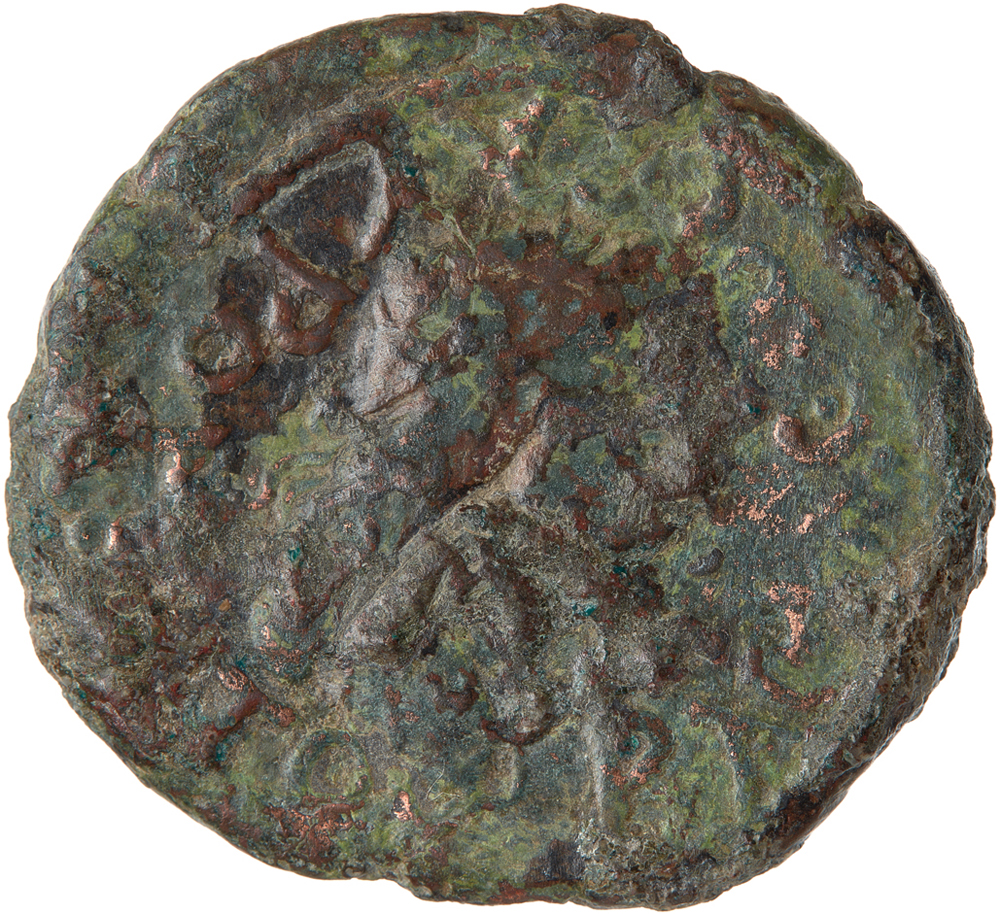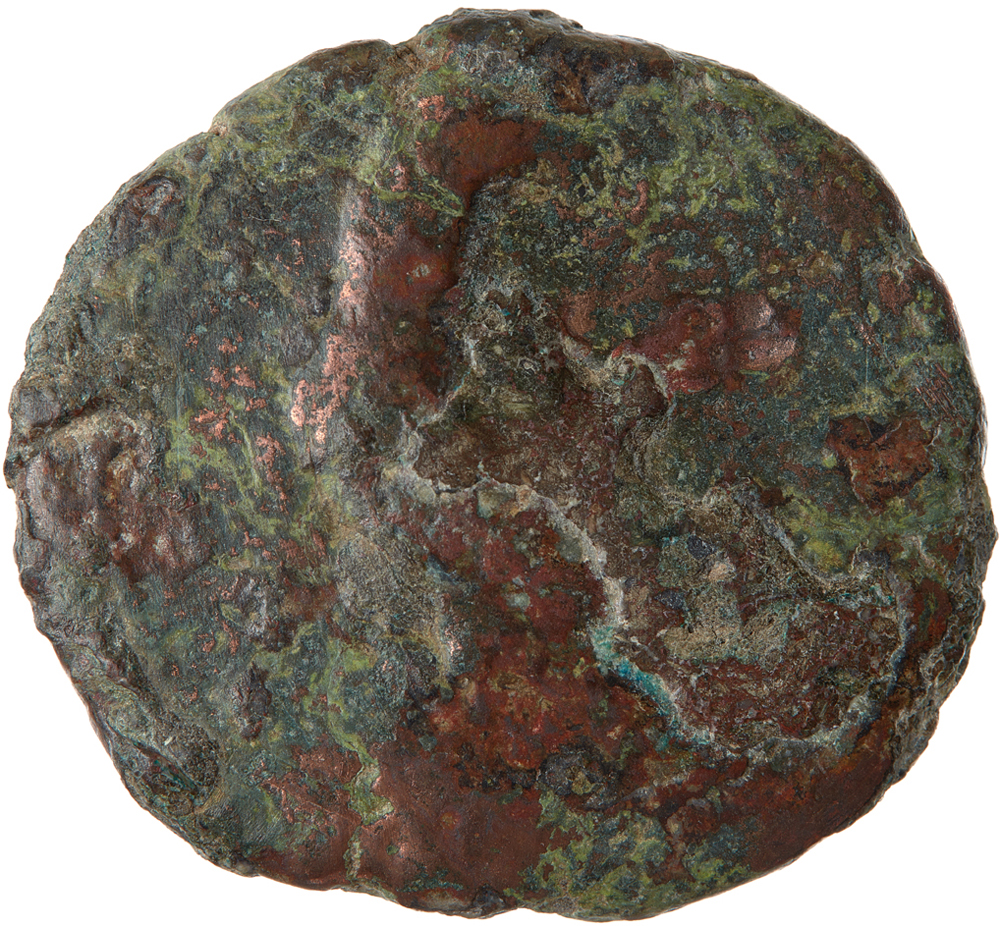A Find of a Bosporan Coin at Trębaczów, site 2, Kazimierza Wielka district (Poland)
Zusammenfassung: Der
Artikel widmet sich einer Bronzemünze von Sauromates II., dem
Herrscher des Bosporanischen Königreichs (174/175–210/211 n.
Chr.). Das Stück wurde bei einer archäologischen Untersuchung
der Siedlung Trębaczów (Fundstelle 2), Kazimierza Wielka Poviat,
entdeckt, die in die Zeit der Przeworsk-Kultur datiert. Vom
Nominal als »Dreifach Sestertius« oder »Drachme« angesprochen,
gehört die Prägung zu den zwei Serien von Bronzemünzen, die in
die Zeit um 186–196 n. Chr. (Zograf 1951; Frolova 1997a) oder in
die Jahre um 180–192 n. Chr. (Anokhin 1986) datiert werden.
Der neu entdeckte Fund erweitert eine kleine Gruppe
bosporanischer Münzen, die zwischen der zweiten Hälfte des 1.
Jahrhunderts v. Chr. und dem 4. Jahrhundert n. Chr. geprägt und
auf dem Gebiet des heutigen Polen entdeckt wurden. Bisher waren
sechs derartige Funde bekannt. Das neue Exemplar fand
wahrscheinlich in der ersten Hälfte oder in den ersten Jahren
der zweiten Hälfte des dritten Jahrhunderts n. Chr. durch
Kontakte zwischen verschiedenen Bevölkerungsgruppen im ost- und
mitteleuropäischen Barbaricum den Weg zur Siedlung der
Przeworsk-Kultur.
Coins minted by the rulers
of the Bosporan Kingdom issued from the second half of the 1st
century BC until the first half of the 4th century AD are
relatively rare finds in the areas of the Roman-period Przeworsk
and Wielbark cultures[1].
Previously, six such finds had been recorded in the area of
present-day Poland, including four in the region historically
known as Lesser Poland, and two in Central Poland: one each in
Mazovia and Kujavia (table 1; map 1)[2].
It should be noted that only the last two discoveries have been
made in recent years, since the use of metal detectors has
become widespread. All the Lesser Poland finds were recorded in
the second half of the 19th century and in the first half of the
20th century. Therefore, each new discovery of a Bosporan coin
is of great importance, not only because of the addition to
range of source material, but because it confirms the older
finds, and is particularly valuable in cases where these remain
doubtful.
Map 1: Finds of Bosporan Coins in Poland: 1 – Gąski, Inowrocław District, Kuyavian-Pomeranian Voivodeship; 2 – Gorlice - Glinik Mariampolski, Lesser Poland Voivodeship; 3 – Nowy Sącz-Zabełcze, Lesser Poland Voivodeship; 4 – Skłóty, Kutno District, Łódź Voivodeship; 5 – Staniątki, Wieliczka District, Lesser Poland Voivodeship; 6 – Trębaczów, Kazimierza Wielka District, Świętokrzyskie Voivodeship; 7 – Zarzecze, Przeworsk District, Subcarpathian Voivodeship. Drawing by Jan Bulas
Recently, a new, seventh
find of a Bosporan coin was registered in western Małopolska in
Trębaczów, commune of Opatowiec, Kazimierza Wielka district (map
1). The discovery was made in March 2020 during a surface
prospection, carried out with a metal detector in a Roman period
settlement by a team of archaeologists from the Arch Foundation[3].
The research, conducted on the basis of permit No. 3493/219
issued by the Provincial Conservation Office in Kielce, is part
of the »Ekspedycja Rzemienowice« (Rzemienowice Expedition)
project, focused on the study of sites from the Roman period in
the valley of the Młyńska stream, a tributary on the left bank
of the River Vistula. Annual surface prospecting, analysis of
satellite images, and aerial prospecting have led to the
discovery of many settlements of the Przeworsk culture in this
area. Numerous Roman imports have been discovered in all the
researched sites, mainly coins and brooches. This pattern
corresponds with the finds from the famous settlement (site 2)
in Jakuszowice, located 8.5 km as the crow flies from Trębaczów[4].
The aforementioned Młyńska valley is located between the valleys
of two much larger tributaries on the left bank of the Vistula,
the Nida and Nidzica rivers. The position of the Młyńska stream
and the settlements on it had undoubted advantages, among them
its location on the extension of one of the most important
routes leading from the south to the north, along the River
Dunajec. This area was undoubtedly part of an important nexus of
cultural and commercial contacts. It should be added that in the
same microregion there are other excavated sites where Roman
coins have been discovered (including Bejsce and Zagórzyce)[5],
and places where accidental discoveries of such items have been
recorded (Chwalibogowice, Stary Korczyn, Uściszowice, Wyszogród)[6].
Site no. 2 in Trębaczów was
discovered in 2017 as a result of analysis of satellite images
and vertical aerial photos taken with an unmanned aerial vehicle
(a so-called drone), which revealed the presence of
characteristic vegetation anomalies correlating with the remains
of sunken or excavated structures typical of the Przeworsk
culture settlements. These observations were confirmed in 2018
during surface surveys. The settlement in question is situated
on a gentle slope in a slightly elevated position above the
river valley. During the research, a large amount of ceramic
material was registered, including hand-made fragments of
Roman-period phase B pottery and Roman-period phase C pottery
made on a potter’s wheel. Finds of metal objects allow for a
more precise determination of the functioning of the settlement
between phase B1 (beginning of the 1st century AD) and at least
the end of phase C1 (around the middle of the 3rd century AD).
In addition to the aforementioned Bosporan coin, ten other Roman
coins were found at the site. These are denarii, including one
republican, and nine imperial specimens from the 1st–2nd century
AD (map 2). The oldest coin is the republican denarius,
an issue of Q. Titus, minted in 90 BC (RRC
341/1), and the youngest is a denarius of Commodus
from AD 187–188 (RIC
III 162 or
167)[7].
It should be added that in Trębaczów there is another settlement
(site 1), located about 400 meters in a straight line
from site 2, where also during surface prospecting one denarius
was discovered, minted during the reign of Nerva.
The Bosporan coin from site
2 was found in the form of a corroded and completely shapeless
metal lump, and was thus originally included in the group of
insignificant ›junk‹ finds[8].
As a result, exact data relating to the place and time of the
discovery were not recorded. Only later, careful inspection of
the material and the conservation undertaken resulted in the
cleaning of the object and its proper identification.
Nevertheless, the precise location of the discovery spot, and
thus the detailed context of the find and its possible
relationship with other coins discovered at site 2 are not
clear.
The specimen found in
Trębaczów was minted in the name of Sauromates II
(174/175–210/211), the king ruling at the turn of the 2nd and
3rd centuries AD (fig. 1); for a similar, better
preserved piece cf. fig. 2). During his long reign, the
ruler minted copious issues. The coin in question belongs to a
series of large bronzes with a portrait of the ruler and the
royal title on the obverse, and an eagle and the denominational
mark (PMΔ = 144 units) on the reverse. According to the
classifications of Aleksandr N. Zograph and Nina A. Frolova,
such coins belong to Sauromates II’s second series of bronze
coinage and were minted in the years AD 180–196[9].
Vladilen A. Anokhin also includes the type in question in the
second series of bronze coins of this ruler, although he dates
it to the reign of the Roman Emperor Commodus (180–192)[10].
The researchers have defined the denomination of the issue as a
triple sestertius, equal to ¾ of one denarius (Zograph,
Anokhin), or as a drachm (Frolova).
Cimmerian Bosporus
Sauromates II (174/175–210/211)
AE, denomination PMΔ
Obv. Diademed and draped bust of Sauromates; r.; ΒΑCΙΛΕWC CΑYΡΟΜΑΤΟΥ; dotted border
Rev. Eagle standing l., head turned back, with wreath in beak; [PMΔ]; dotted border
11.88 g; 29.4 mm; 12 h
Cf. Frolova 1997a, Pl. XCI, 17; Anokhin 1986, 165 no. 618a, Pl. 29; RPC IV Temp. No. 3879
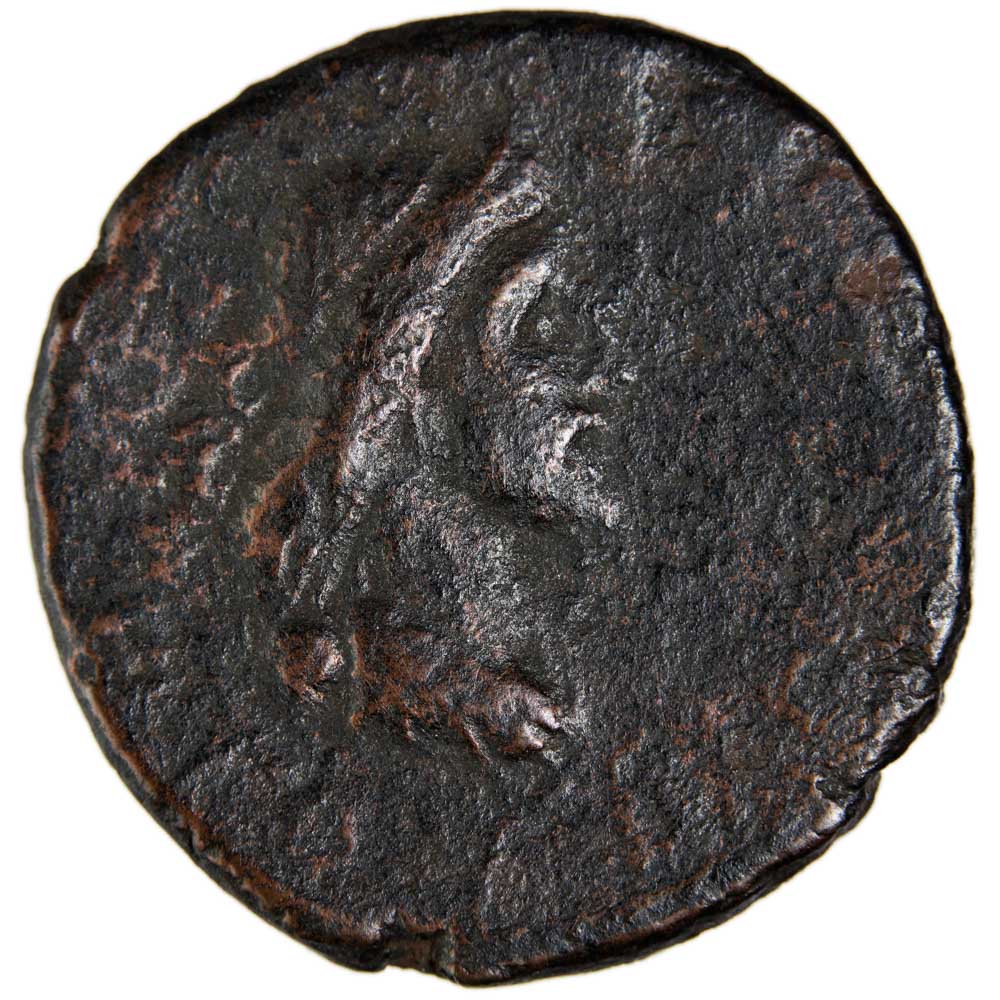
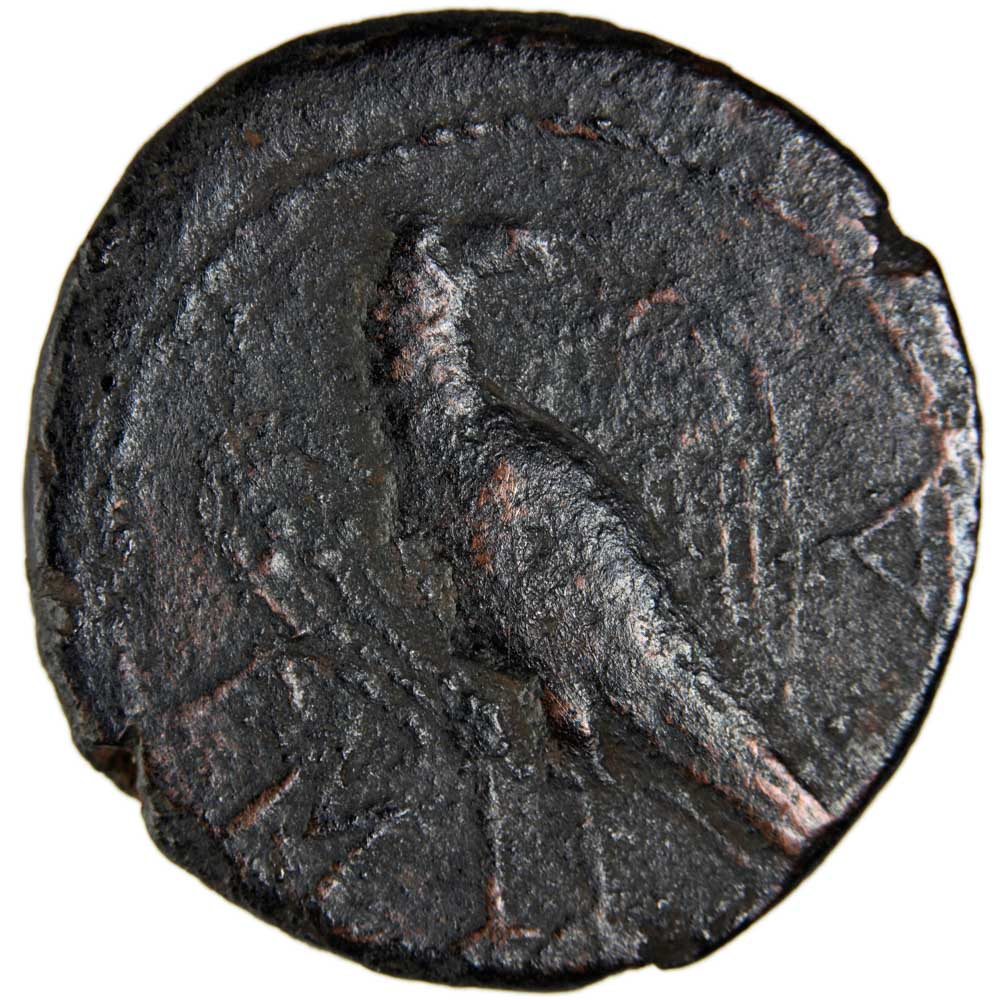
The National Museum in Krakow; Donation of Lech Kokociński; Inv. No. MNK VII-A-6899
Photo courtesy of the National Museum in Krakow
Among the relatively
infrequent finds of Bosporan coins in Poland, no discoveries of
specimens minted by Sauromates II have been recorded so far (cf.
table 1)[11].
The closest chronologically to the coin from Trębaczów are the
middle bronze (›denarius‹) of his successor Rhescouporis III
(211/212–228/229) discovered in Staniątki, Wieliczka district (table
1, no. 5)[12]
and the so-called ›denarius‹ of Ininthimaeus (234/235–238/239)
found in Skłóty, Kutno district (table 1, no. 6)[13].
When analyzing the overall chronological structure of the finds
of Bosporan coins discovered in Poland, two groups can be
distinguished. One is made up of coins minted in the 1st century
AD, effectively consisting of issues from the second half of the
century: a bronze of Cotys I (45–68) found in Zarzecze,
Przeworsk district (table 1, no. 2)[14]
and a sestertius of Rhescouporis II (68/69–91/92), which is part
of the alleged hoard discovered in Glinik Mariampolski (now part
of Gorlice)[15].
The other group includes the aforementioned coins from the 1st
half of the 3rd century AD and the newly discovered coin of
Sauromates II. In addition to these groups, there is also a
small bronze of Polemon (15–9 BC) from the vicinity of Nowy Sącz
(table 1, no. 1), (Nowy Sącz-Zabełcze)[16]
and, due to the lack of a precise description, a large bronze
(sestertius) of an unspecified Bosporan ruler minted in the 1st
or 2nd/3rd century AD, found in Gąski, Inowrocław district (table
1, no. 7)[17].
In the latter case, the exact identification of the coin would
allow an attribution to the first or second group. It should be
noted, however, that the different chronological structure of
the groups of finds of Bosporan coins does not necessarily have
to be significant in the context of the chronology of their
influx into the area of today’s Poland (see below). What is
noteworthy, however, is the lack among Polish finds of Bosporan
coins minted in the second half of the 3rd and 4th century AD
(see below). Unless this is the result of the state of research,
the lack of these coins may be important for determining the
time of the influx of Bosporan coins into present-day Polish
territory[18].
The chronology of Bosporan
coins found in Poland is closely related to their denominational
structure (cf. table 1). The finds consist only of bronze
coins. Furthermore, apart from the coin from Nowy Sącz-Zabełcze
(table 1, no. 1), these are items that can be classified
as medium (›denarii‹) or large bronzes (sestertii, triple
sestertii/drachms) and therefore similar in size to large
imperial bronzes. This gives rise to a thesis that at least some
of these coins performed a similar function in the Barbaricum as
large imperial bronzes[19].
The latter are relatively rare in finds from the Przeworsk
culture area, compared to the finds of denarii or their
imitations. It is also worth recalling that so far no finds of
gold, electrum, silver or bronze Bosporan staters have been
registered in the area of today’s Poland.
All the finds of Bosporan
coins recorded in contemporary Poland so far come from the areas
covered by the settlement of the Przeworsk culture during the
Roman period. One can only perhaps consider whether in the case
of the find from Nowy Sącz-Zabełcze (table 1, no. 1),
based on the date of the influx of the Polemon coin, it should
not be associated with the Puchov culture. So far, we do not
know of such discoveries from the settlement area of the
Wielbark culture or the Masłomęcz group. It seems, however, that
this is an effect of the state of the research rather than a
reflection of the real situation. Recently, Dr.
Kirylo
Myzgin identified a find of a coin minted in Chersonesus,
possibly from the area of the Masłomęcz group, which
potentially confirms the presence of coins from the region of
the northern Black Sea shores in the territory of contemporary
Poland covered by Gothic settlement during the Roman period[20].
At the same time, it should
be emphasized that numerous finds of coins of the rulers of the
Bosporan Kingdom have been registered in today’s Ukraine and
Russia, mainly in the Cherniakhiv Culture area[21],
and also, less numerously, in today’s Moldova, Belarus, and
Lithuania[22].
With a small number of finds of such coins in the Roman Balkan
provinces and their practical lack in the territories of today’s
Slovakia, the Czech Republic and the eastern German Länder, the
eastern or south-eastern direction of their influx into today’s
Poland seems to be the most likely[23].
The Polish lands seem to constitute the western border of the
influx of coins of interest to us in the area of the European
Barbaricum. Several finds that form a cluster in the area of
today’s Saarland, Hessen, and Baden-Württemberg, i.e. the
western and south-western German Länder, should rather be
associated with a different historical and cultural context[24].
Among the various
hypotheses concerning the circumstances of the influx of
Bosporan coins into present-day Polish lands, the most probable
seems to be one that links them with internal Barbarian
interactions, primarily between the Sarmatians and/or people of
the Cherniakhiv, Wielbark and Przeworsk cultures[25].
This type of contact is certainly evidenced by non-numismatic
phenomena present in the archaeological material[26].
They intensify from the second half of the 2nd century AD. At
that time a clear movement of the Przeworsk and Wielbark Culture
population to the east and south-east occurred[27].
Those migrations are widely connected with movements of the
Vandals and the Goths which are recorded in the historical and
led to the significant changes in the cultural situation in
Central and Eastern European Barbaricum during the 3rd century
AD[28].
The nature of any contacts, however, remains unclear, at least
for the time being, and the question of whether they were
commercial, social, or political contacts remains open. Perhaps
they were of a complex and varied nature.
In their studies on finds
of Bosporan coins in the Cherniakhiv Culture area, Georgiy
Beidin and Myzgin distinguished among them three chronological
groups. The first consists of coins minted before the so-called
Gothic Wars, the second of issues struck during those wars, and
the third of coins minted after their conclusion[29].
As a consequence, they proposed a three-phase influx of Bosporan
coins, where the individual phases are represented by coins they
classified into the three groups mentioned above. Relating this
division to the finds from Poland (which it should once again be
emphasized were much less numerous) we can confirm that they are
made up of coins corresponding to the first and second groups of
Beidin and Myzgin. With the small sample of ›Polish‹ finds, it
is difficult, however, to assign precisely particular
discoveries to the first or second group, and thus to
differentiate the time of their influx according to the time of
their release[30].
In fact, perhaps, apart from the very early coin of Polemon,
allegedly discovered in Nowy Sącz-Zabełcze (table 1, no. 1),
it is difficult to place the influx of any Bosporan coin from a
›Polish‹ find into a period earlier than the 2nd half of the 2nd
century AD. In the case of the coins that we have classified in
the second chronological group, this is self-evident, because
they were minted in the last quarter of the 2nd century AD or
later. The coin of Rhescouporis II (68/69–91/92), which was
assumed to be part of the hoard found in Gorlice-Glinik
Mariampolski (table 1, no. 3), could have reached the
Polish Carpathians not earlier than around the middle of the 2nd
century AD, as indicated by the current dating of this deposit[31].
In fact, uncertainty remains only in the case of finds from
Zarzecze, Przeworsk district (table 1, no. 2) (the coin
of Cotys I (45–68) and Gąski, Inowrocław district (table 1,
no. 7) (an undefined king of the 1st, 2nd or 3rd century
AD). It seems, however, that in these cases there are also some
reasons not to exclude them from the influx in the second half
of the 2nd century AD, or even later. The coin from Zarzecze (table
1, no. 2) was discovered along with a coin minted in Ascalon
in the 1st or 2nd century AD[32].
As for the piece from Gąski (table 1, no. 7), it cannot
be ruled out that it was minted as early as the second half of
the 2nd or the beginning of the 3rd century AD. Therefore, it
seems that most of the Bosporan coins found their way to today’s
Poland in the second half of the 2nd or more probably in the 3rd
century AD.
Other monetary finds also
provide a point of reference for dating their influx.
Simplifying and briefly
describing the issue of the influx of Roman coins to the Central
European Barbaricum, we can summarize this problem as follows:
most Roman coins minted at imperial mints in the 1st and 2nd
centuries AD found their way to the present Polish lands in the
last decades of the 2nd and/or the beginning of the 3rd century
AD[33].
Some of them, however, could also have arrived even later, in
the next two centuries, as a result of the redistribution of the
pool of, mainly, denarii and, to a lesser extent, other coins in
the Barbarian environment comprising the populations of various
archaeological cultures (Przeworsk, Wielbark and Cherniakhiv
Cultures) identified in the area of Central and Eastern
European Barbaricum[34].
During the later phases of the 3rd century AD, denarii and
antoniniani of the 3rd century minted after the reign of
Septimius Severus, gold aurei and imperial AEs from the 1st–3rd
centuries AD, debased radiates from the 2nd half of the 3rd
century AD, as well as smaller numbers of subaerati and other
categories of counterfeits, copies and imitations of Roman coins[35].
Again, some of these objects, mainly the copies and imitations,
could have come to today’s Polish lands even later. Therefore,
even given that certain groups of coins – Greek, Roman
Republican issues and Celtic, and maybe even Dacian imitations –
found their way to the Central European Barbaricum earlier, it
is difficult to accept the thesis that the Bosporan coins
arrived before the main mass of Roman coins[36].
Again, a possible exception could be the coin of Polemon found
near Nowy Sącz-Zabełcze. Another interesting point of reference
for the chronology of the finds of Bosporan coins is the
chronological structure of coins minted in the Provincial mints
and found within the borders of modern Poland state[37].
Of course, bearing in mind
the various possible circumstances of the influx of the Roman
provincial coins found in Poland, it is important to note that
the vast majority of them were minted in the 3rd century AD,
during the reigns of the Severan dynasty or later. It can
therefore be assumed that it was during the third century AD
that the greatest influx of provincial coins into the territory
of contemporary Poland occurred[38].
This is confirmed by the broader perspective of finds from the
areas of the settlement of the Cherniakhiv Culture, where
numerous provincial coins were discovered, most of which were
minted in very similar periods to those most frequently
represented in Polish finds[39].
As already mentioned, the contacts among the Przeworsk, Wielbark
and Cherniakhiv cultures played an important role in the
redistribution of Roman coins.
Taking all this into
account, it can be hypothesized that the majority of Bosporan
coins found in Poland, regardless of the date of their minting,
arrived in the 3rd century AD, perhaps along with some
provincial coins and imitations of denarii from area of the
Cherniakhiv Culture[40].
This also applies to the coin found in Trębaczów (table 1,
no. 4) that is presented here. At the same time, it is
impossible to answer unequivocally the question whether the
influx of Bosporan coins was the result of events directly
related to the Gothic Wars, or whether a different, perhaps more
complex reason is behind it. On the other hand, these coins
could not have arrived in present-day Poland very late. The lack
of finds of Bosporan coins, mainly staters, minted in the 2nd
half of the 3rd and in the 4th century AD, seems to provide
indirect evidence for. It is true that their absence may be the
result of the state of research, but currently we do not know of
a single find of such a coin in Poland, althoug such finds are
recorded in the Cherniakhiv Culture area[41].
Adding to this the fact that so far the latest Bosporan coin
from Poland is a ›denarius‹ of Ininthimeus (234/235–238/239), we
can cautiously assume that the influx of Bosporan coins to the
Polish lands ended at the latest in the middle, or possibly in
the early years of the second half, of the 3rd century AD.
The find of the coin of
Sauromates II in Trębaczów (table 1, no. 4) is very
important for a further reason. It is the first discovery of a
Bosporan coin from Poland made during regular archaeological
research. Because of this, it confirms the influx of such coins
to Polish lands in the Roman period, and gives credibility to
other finds made accidentally or by so-called detectorists.
Although the coin does not have a strict archaeological context,
its connection with a Roman period settlement is indisputable.
It is therefore, like other so-called imports, including coins,
testimony to the interregional connections between the
settlement in Trębaczów, the microregion in which the settlement
was located, and the broader context of the western Małopolska
settlements inhabited during the Roman period by the people of
the Przeworsk culture. Furthermore, in this context, it is worth
mentioning the Roman provincial coins found in the famous
settlement in Jakuszowice, located, as mentioned, only 8.5 km
away (site 2)[42].
Together with other sorts of imports they proof links between
western Małopolska and other regions of Barbaricum and
Rome. The nature of these links has been not fully explained,
but regardless of whether they were direct or indirect contacts,
their interregional nature is not open to discussion.
|
No |
Reign |
Metal |
Denomination |
Dates |
Find spot |
References |
|---|---|---|---|---|---|---|
|
1 |
Polemon (15–9) |
AE |
|
15–9 BC |
Nowy Sącz
–Zabełcze |
Frolova 1997a,
42, type III, Pl. XV, 15–16a |
|
2 |
Cotys I (45–68) |
AE |
|
AD 63–68 |
Zarzecze,
Przeworsk District |
Frolova 1997a, 10 f., Pl.
XIV, 7–10;
RPC I no. 1930 |
|
3 |
Rhescuporis II
(68/69–91/92) |
AE |
Sestertius |
AD 80–93 |
Gorlice-Glinik
Mariampolski |
Frolova 1997a, 105, 1st
group, Pl. XXXI, 4–15;
RPC II no. 469 |
|
4 |
Sauromates II
(174/175–210/211) |
AE |
Triple
sestertius |
AD 180–196 |
Trębaczów,
Kazimierza Wielka District |
Frolova 1997a, Pl. XCI,
17;
RPC IV Temp. No. 3879 |
|
5 |
Rhescuporis III
(211/212–228/229) |
AE |
›Denarius‹ |
AD 211–215 |
Staniątki,
Wieliczka District |
Frolova 1997b,
10 f., Pl. XIV, 7–10 |
|
6 |
Ininthimeus
(234/235–238/239) |
AE |
›Denarius‹ |
234/235–238/239 |
Skłóty, Kutno
District |
Frolova 1997b, 37, 232,
Pl. XXXVII, no. 13;
RPC VII,2 –(unassigned;
ID 3499) |
|
7 |
Undetermined
ruler |
AE |
Sestertius |
End of 1st to
beginning of the 3rd cent. AD |
Gąski,
Inowrocław District |
Cf. Frolova
1997a, Pls. XLIV–LXI |
[1]
The authors
would like to
express their profound thanks to
Dr. Kirylo
Myzgin and Dr. hab. Arkadiusz Dymowski from the
University of Warsaw for valuable comments and remarks
on this text and to Dr. Ulrich Werz and Claire Franklin
for making our English readable. At the same time, we
would like to emphasize that all errors and shortcomings
are borne solely by ourselves.
[2]
Bodzek – Madyda-Legutko 2018; Bodzek – Madyda-Legutko
2013; Bodzek – Jellonek – Zając 2019, 60–62.
[3]
The research is
conducted by Jan Bulas, MA, Michał Kasiński PhD, an
employee of the Jagiellonian University, and Magdalena
Okońska-Bulas, MA.
[4]
On the
settlement from the Roman period and the early phase of
the migration period in Jakuszowice see Godłowski 1986;
Godłowski 1991; Godłowski 1995; Kaczanowski – Rodzińska
Nowak 2010. On monetary finds
at this site: Bursche 1997a; Bursche – Kaczanowski –
Rodzińska-Nowak 2000; Bodzek 2021; further bibliography
there.
[5]
Zagórzyce: Grygiel – Pikulski – Trojan 2009a; Grygiel –
Pikulski – Trojan 2009b; Bodzek 2009; Bodzek et al.
2016; Bejsce: Opozda 1967; Kunisz 1985, 24 f. no. 4;
Kaczanowski – Margos 2002, 9 no. 13; Kasiński – Bulas –
Okońska 2019.
[6]
Cf.
Kaczanowski – Margos 2002, 36 nos. 88–89; Komorowska
2014, 10 (Chwalibogowice); Kaczanowski – Margos 2002,
306–307 no. 728 (Stary Korczyn); ibidem 338 no. 822
(Uściszowice); ibidem 353 no. 875 (Wyszogród).
Further
bibliography there.
[7]
Roman denarii
found in the Przeworsk culture settlement in Trębaczów
will be the subject of a separate study.
[8]
Nota bene, it is
worth considering to what extent similar situations
affect the level of registration of finds. This
especially applies to discoveries made by so-called
detectorists, who when making uninteresting finds such
as such shapeless corroded copper nuggets might simply
throw them away. We thank Dr. K. Myzgin for this remark.
[9]
Zograph 1951,
204–205; Frolova 1997a, 149–153, especially p. 152 type
16.
[10]
Anokhin 1986, 116, 165 no. 618a.
[11]
It cannot be
ruled out that the bronze found in Gąski, Inowrocław
district (cf. table 1, no. 7) should be dated to
the
to the reign of Sauromates II.
A precise definition of this poorly preserved coin,
known to the authors of the present text only from
photographs, is not possible cf. Bodzek – Madyda-Legutko
2018, Cat. 1.
[12]
Ibidem, Cat. 5.
[13]
Bodzek –
Madyda-Legutko 2013; Bodzek – Madyda-Legutko 2018, Cat.
4.
[14]
Ibidem, Cat. 6.
[15]
Ibidem, Cat. 2.
[16]
Ibidem, Cat. 3
[17]
Cf.
note 11.
[18]
Cf. Bodzek – Madyda-Legutko 2018, 56–57.
[19]
Cf.
Bodzek – Jellonek – Zając 2019, 69.
[20]
Personal communication; the piece is stored in the
St. Staszic Hrubieszów Muzeum.
[21]
Beidin 2017;
Beidin 2018; Myzgin – Beidin 2012; Myzgin – Beidin 2015.
[22]
Sidarovich
2011; Sidarovich 2014; Michelbertas 2001, 58.
[23]
Bodzek – Madyda-Legutko 2018,
73–77. The Dacian direction of
the influx is less likely, although not entirely ruled
out. In today’s Romania, Bosporan coins were registered
in Horia, Tulcea County – bronze of Sauromates I (Mitrea
1964, 380 no. 52; Kunisz 1992, 158) – and in Poiana,
Galaţi County – bronze of Aspurgos (Mitrea 1978, 366 no.
63), gs. 2: 2–3 (367).
[24]
Cf.
Bodzek – Myzgin 2021.
[25]
Cf.
Dobrzańska 1999; Bodzek – Madyda-Legutko 2018, 73–77.
Among the numismatic evidence of interactions between
the populations of the aforementioned archaeological
cultures is the recording of finds of imitations of
Roman denarii, minted with the same dies, in the areas
of all three cultures; cf. Dymowski 2019a.
[26]
Cf. ibidem, especially 73–79.
[27]
Andrzejowski 2019; Andrzejowski 2021.
Further
bibliography there.
[28]
Bulas 2020.
[29]
Myzgin – Beidin 2012, 60 f.
[30]
G. Beidin (2017,
4) pointed to the possibility of assigning coins
formally classified to the first group to group 2 on the
basis of the presence of countermarks. Counter-marks
testifying to long circulation would make it possible to
distinguish between coins used before (in this case,
coins without countermarks) and during the Gothic Wars
(countermarked). However, this theory is difficult to
apply in relation to Polish finds, among which no
countermarked specimens have been registered so far. As
shown below, despite the lack of countermarks, most of
the Bosporan coins probably came to the present-day
Polish lands only at the end of the 2nd–1st half of the
3rd century AD.
[31]
Cf. Bodzek – Madyda-Legutko 2018, 67.
[32]
The problem in
this case is the very unclear relationship between these
finds. In principle, it is not known whether the coins
in question were found together, whether the finds were
made on the same day, or whether they were simply
acquired on the same day. Cf. Bodzek – Madyda-Legutko
1999; Bodzek – Madyda-Legutko 2018, 71.
[33]
A. Bursche (cf.
e.g. Bursche 1994, 472–475; Bursche
2004, 196–198;
Bursche 2006, 222) and M. Erdrich (2001,
127 f.)
date the beginning of the aforementioned wave to the
time of the Marcomannic Wars (167–180 CE). According to
R. Wolters (1999, 385–386), the influx of denarii may
have started under Antoninus Pius (138–161) or Marcus
Aurelius (161–180), and T. Lucchelli (1998, 160 f.)
indicates the period from Trajan (98–117) to Antoninus
Pius as the beginning of the great wave of Roman silver.
A. Dymowski allows for three possibilities of the
arrival of the first imperial denarii: 1) in the final
period of Trajan’s reign (in connection with the Dacian
Wars [101–106]); 2) in the final years of Hadrian’s
reign (117–138) or during the reign of Antoninus Pius;
or 3) the beginning of a first large wave in the middle
of the reign of Antoninus Pius or under Marcus Aurelius,
and another great wave in the first years of the reign
of Septimius Severus (Dymowski 2013, 111–114). The end
of the influx of the great wave of denarii would have
taken place according to various concepts at the time of
Commodus (177–192) or at the beginning of the reign of
Septimius Severus (193–211) (e.g. Bursche 1994; Bursche
2006, 222; Lucchelli 1998, 160–162; Wolters 1999,
385–386; Erdrich 2001, 127 f.; Dymowski 2013, 113).
[34]
Cf. Dymowski 2019a.
[35]
A. Bursche and
A. Dymowski date the influx of third-century denarii to
the years 30–40 of the 3rd century AD. Cf. Bursche 2004,
201; Dymowski 2013, 113–114); on the problem of the
influx of Roman coins minted in the 3rd century AD and
later see Bursche 1996; Dymowski 2012; Dymowski 2013;
the issue of subaerati, copies and imitations of Roman
coins in Poland are discussed in Bursche 1997b; Bursche
– Kaczanowski – Rodzińska-Nowak 2000; Dymowski 2017;
Dymowski 2019a; Dymowski 2019b; Dymowski 2020; Dymowski
2021; Romanowski – Dulęba 2018; Więcek 2019. Of course,
we cannot exclude the production of some subaerati,
imitations or copies in the area of Wielbark or the
Przeworsk culture (cf. Dymowski 2020). Dymowski 2018
presented general comments on the influx of Roman coins
to the area of Lesser Poland.
[36]
On finds of Greek
coins minted before the 1st century BC see Mielczarek
1989; Mielczarek 1996; Mielczarek 2008; about Celtic and
other barbarian coins, e.g. Rudnicki 2012a; Rudnicki
2012b; Rudnicki 2013; Rudnicki –Miłek 2009; Rudnicki
–Miłek 2011; Florkiewicz 2009; Dulęba – Wysocki 2017; on
coins of the Roman Republic Dymowski 2016; Dymowski –
Rudnicki 2019.
[37]
Cf.
Bodzek – Jellonek –
Zając 2019.
[38]
Cf.
Bodzek – Jellonek – Zając 2019, 68.
[39]
Cf.
Myzgin 2011; Myzgin 2012; Myzgin 2015; Myzgin 2017;
Myzgin 2018.
[40]
On the
possibility of influx to the Barbaricum of the 3rd
century AD denarii and antoniniani thanks to the
contacts between the Roman Empire and the Goths (i. e.
de facto the Cherniakhiv culture), see Dymowski 2013,
114; Dymowski 2017; Dymowski 2018, 46; Dymowski 2019a.
[41]
Myzgin – Beidin 2012.
[42]
Cf.
Bodzek – Jellonek – Zając 2019, 70; Bodzek 2021.
